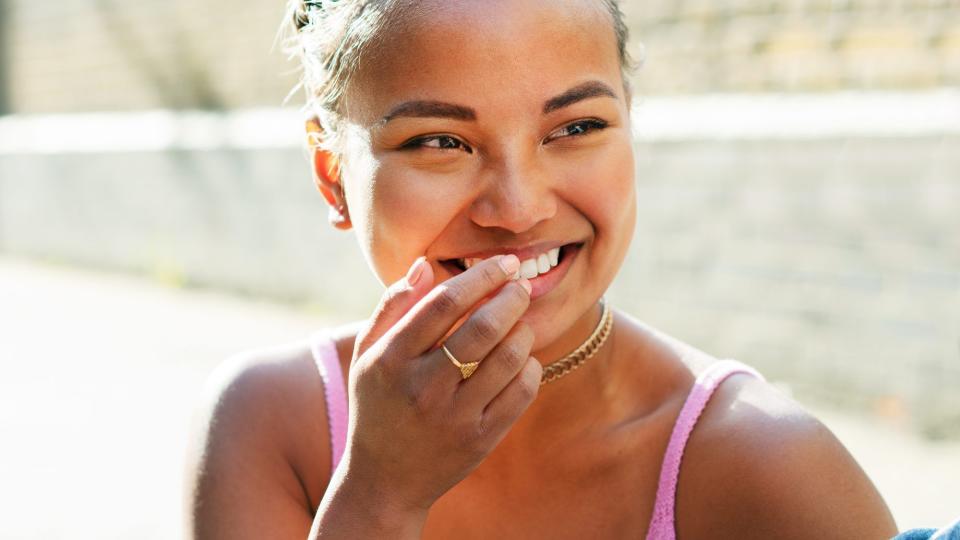7 Common Teeth Whitening Mistakes to Avoid
Teeth whitening is more popular—and accessible—than ever. Most dental practices offer professional whitening, and now many stores sell at-home teeth whitening kits to use on your own time. While this means more affordability, it also leads to potential teeth-harming mistakes. That's not to say that achieving a reality TV star-esque smile isn't impossible to DIY—it just means you have to do your homework. We asked professionals to share their top teeth whitening mistakes, and how you can avoid them.

Getty Images
Using whitening toothpaste daily
Over-the-counter whitening toothpaste provides an almost-instantly brighter smile; but it may also cause damage when used for long periods, according to Jennifer Berg, RDH, a dental hygienist in Massachusetts. "This type of toothpaste, including charcoal toothpastes, usually contains abrasives to create that polished effect," explains Berg.
Continued use of abrasive toothpaste can remove tooth enamel and cause gum recession, exposing the tooth's root surface and leading to painful tooth wear. Instead, Berg recommends using a multi-purpose fluoride toothpaste daily.
Not talking to your dentist before whitening
Although it's easy to be impulsive when seeking a whiter smile, it's best to consult your dentist before experimenting with bleaching methods. Your dentist can determine if you're a good candidate for whitening and, if so, can suggest the best whitening treatment for you. "Not seeking guidance from your dentist before bleaching can have long-term negative effects," says Berg.
"People who have tooth-colored fillings or restorations (including crowns and veneers) in their 'smile zone' should limit the whitening they do." That's because crowns, veneers, and fillings are made of porcelain or composite materials which, unlike enamel, does not whiten and may look darker in comparison to natural teeth after whitening. Better to be safe and talk to your dentist first.
Overusing whitening strips
Whitening strips are a simple and inexpensive way to brighten your smile but, like whitening toothpaste, prolonged use isn't good for your pearly whites. The same goes for leaving the strips on longer than recommended. According to Berg, prolonged use can hurt your gums, increase tooth sensitivity, and cause bright splotches. Make sure to always follow the directions that come with your whitening strips.
Using one-size-fits-all whitening trays
As tempting as it is to buy the over-the-counter trays, custom-made bleaching trays work best. "Everyone's mouth is different," says Berg. "Using a tray that isn't custom to your mouth can cause leakage of the whitening product chemicals, which can lead to tooth damage and gum irritation. Additionally, saliva can deactivate the whitening properties in the peroxide."
Unfortunately, the whitening trays sold in stores and online are usually one-size-fits-all, which can make teeth whitening unsafe and unpredictable. So, to avoid unpleasant repercussions of using ill-fitting whitening trays, best to see a professional.
Not brushing or flossing beforehand
Whitening your teeth should always supplement to your oral care routine, not a replacement. Plaque and bits of food left on your tooth's surface can interfere with the brightening process, so prepping your tooth's surface before whitening reaps the best results. "If there is residue on your teeth, it will prevent the whitening product from seeping into your tooth's enamel and down to the stains," says Berg.
Eating acidic fruits to whiten teeth
According to Michael Gulizio, DMD, MS, cosmetic dentist and co-founder of Core Smiles; this is a "really, really bad idea." "Acidic fruits have a low pH, which means that they are very effective in dissolving dental enamel," he says. "Once enamel has been lost, it won't grow back. The erosive process that dissolves tooth enamel can cause tooth sensitivity, dental cavity, and ultimately gum tissue recession."
Treating it like a one-time thing
Like brushing your teeth, teeth whitening must be implemented regularly to maintain the whitest smile. "If you recently had a whitening done, you likely have obtained the 'whitest-white' possible," says Steven Cordoves, DDS, cosmetic dentist and co-founder of Core Smiles. "However, if you consume a lot of red wine, coffee, tea, and/or tobacco on a regular basis; you may need to whiten more often. The bottom line is to trust your dental professional's advice; he or she knows your teeth and how often you should be whitening them."

